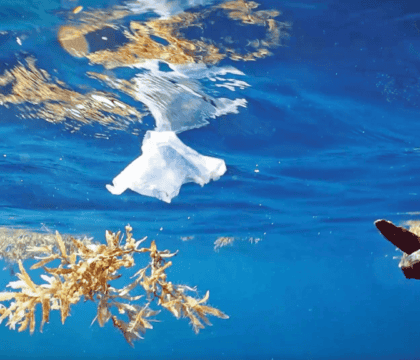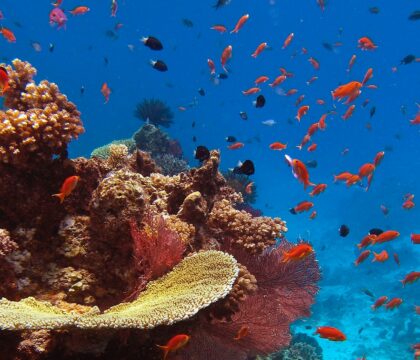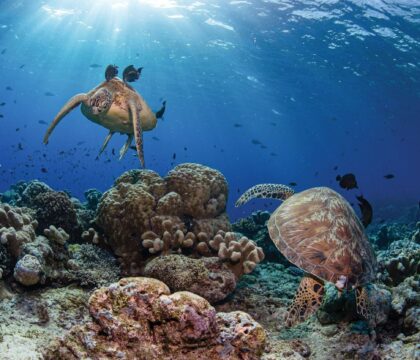December 27, 2020 • Travel Ideas
Guyana is a country of untamed natural beauty. One of the most biodiverse areas of the world, Guyana is also one of the few places left where mankind has made relatively little impact. Having a population just under 800,000, with 90% of the people concentrated along the coast, more than two-thirds of Guyana is still covered by tropical rainforest. The only English speaking country in South America, it boasts a 450-mile Atlantic coastline and shares its borders with Venezuela, Brazil, and Suriname.

More than two-thirds of Guyana is covered in tropical forest. © Pete Oxford
Guyana is an Amerindian word that is thought to mean “land of many waters,” and it is Guyana’s numerous rivers that provide essential highways into some of the country’s unique ecosystems. In those ecosystems, you will find more than 225 species of mammals, 470 species of freshwater fish, 800+ species of birds, and 325 species of amphibians and reptiles.
Beyond the sheer number of species found in Guyana, it is also home to a number of exceptionally large plants and animals as well as giant natural features that have earned it the nickname “Land of the Giants.” The chance to come face-to-face with these natural “giants” is one of the most compelling reasons to visit Guyana. Our Guyana expedition was custom designed with those unique opportunities in mind, and is led by Guyana expert and renowned wildlife photographer Pete Oxford, who has shared his images with us in this post.
7 Giant Reasons to Visit Guyana
1. Giant Falls (Kaieteur Falls)

Kaieteur Falls is the world’s largest single-drop waterfall. © Pete Oxford
One of South America’s most amazing natural wonders is the largest single drop waterfall in the world—Guyana’s Kaieteur Falls. With a 740-foot drop, Kaieteur is almost five times higher than Niagara. In full flow, nearly 23,000 cubic feet of water per second cascades over the falls and creates a cloud of mist and spray that support a unique bromeliad microenvironment. Here, tiny golden frogs live their entire life inside the water-filled leaves. With only around 3,000 visitors per year, it is not uncommon to have the entire park to yourself during a visit!
2. Giant Otters

Giant otters eat 6 to 9 pounds of fish per day. © Pete Oxford
Found throughout South America, the giant otter (Pteronura brasiliensis) is the world’s largest member of the mustelid family (otters, weasels, and ferrets), growing to up to 6-feet in length and nearly 75 pounds in weight. These semi-aquatic mammals have webbed feet, water-repellent fur that keeps them dry and warm, and nostrils and ears that keep water out. Fish make up most of the giant otter’s diet, and they eat six to nine pounds per day. Their fur is a dark brown color with a white or beige patch that extends from their jawline onto their chest. This patch is unique on each animal and can be used to identify individuals. Guyana provides important habitat for giant river otters and is home to one of the world’s foremost otter conservation projects at Karanambu, founded by legendary otter conservationist Diane McTurk.
3. Giant Anteaters

Found on Guyana’s savannas, giant anteaters can reach 7 feet in length. © Pete Oxford
Found on Guyana’s savannas, the impressive giant anteater (Myrmecophaga tridactyla) can reach 7-feet in length from the tip of its snout to the end of its tail. They use their sharp 4-inch-long claws to tear open anthills, and use their long tongues (flicking them up to 160 times per minute) to eat as many as 30,000 ants and termites each day. The giant anteater has the longest tongue in relation to its body size of any mammal, with a tongue that measures about 2-feet long. This amazing tongue has tiny, backward-pointing spines covered in sticky saliva that aid in feeding. The giant anteater relies on a sense of smell that is 40 times more powerful than ours in order to detect ant mounds.
4. Giant Eagles (Harpy Eagles)

The Harpy Eagle is one of the world’s largest eagles, and Guyana’s rainforests offer some of the best chances to see Harpy Eagles in the wild. © Pete Oxford
Sometimes called the “flying wolf” the Harpy Eagle is one of the world’s largest eagles and the most powerful raptor in the rainforest. Adult female Harpy Eagles can weigh 15-20 lbs a weight they maintain through a diet of primarily arboreal mammals, including sloths and small monkeys. Harpy Eagles have yellow feet that are as big as a human hand, and, at 5 inches long, their curved rear talons are larger than a grizzly bear’s claws. The Harpy’s talons are extremely powerful and they can lift more than three-quarters of their body weight. Guyana’s rainforests offer some of the best chances to see Harpy Eagles in the wild.
5. Giant Fish (Arapaima)

Arapaima grow to 10-feet in length and weight up to 400 pounds. © Pete Oxford
Guyana’s freshwater ecosystems provide key habitat for the largest freshwater fish with scales in the world, the arapaima (Arapaima gigas), which can weigh more than 400 pounds and reach 10 feet in length. With the ability to breathe air through a primitive lung, the arapaima can easily live and feed in oxygen-poor backwaters where gill-breathing fish cannot. These fish belong to the group of bony-tongued fish, possessing a tongue made of bone studded with small teeth. The roof of their mouth is also bone studded with teeth, which allows the arapaima to eat armored catfish that other river fish cannot.
6. Giant Rodents (Capybaras)

Found throughout Guyana’s rainforests along rivers, lakes, and wetlands, capybaras are the world’s largest rodents. © Pete Oxford
The unique capybara is the largest rodent in the world. This semiaquatic mammal can weigh more than 100 lbs (the largest recorded was a 201 lb female) and can stay submerged underwater for up to 5 minutes. Capybaras have coarse hair that is thinly spread over their skin, making it possible for them to get sunburned. To prevent this, they roll in mud to coat their skin. Capybaras can be found throughout Guyana in rainforests and along the banks of rivers, lakes, marshes, and in wetlands.
7. Giant Plants (Victoria amazonica)

The giant water lily, Victoria amazonica, is the largest water lily on Earth and Guyana’s national flower. © Pete Oxford
The giant water lily, Victoria amazonica, is the largest water lily on Earth and Guyana’s national flower. It can have leaves that are nearly 10 feet in diameter. Under their surface, the leaves are red and have sharp spines that protect the plant from herbivorous fish. The giant water lily has white flowers with a sweet smell that can measure 10-12 inches in diameter. The chance to see these majestic flowers bloom at dusk is one of the highlights of our Guyana expeditions.
These seven superlative reasons to visit Guyana merely scratch the surface of this little-known country’s spectacular natural riches. For more information about our Guyana trips and the many natural wonders that await you in this off-the-beaten path destination, see our Guyana: Pristine Rainforest, Savanna, and Wetlands itinerary and plan your next adventure.




